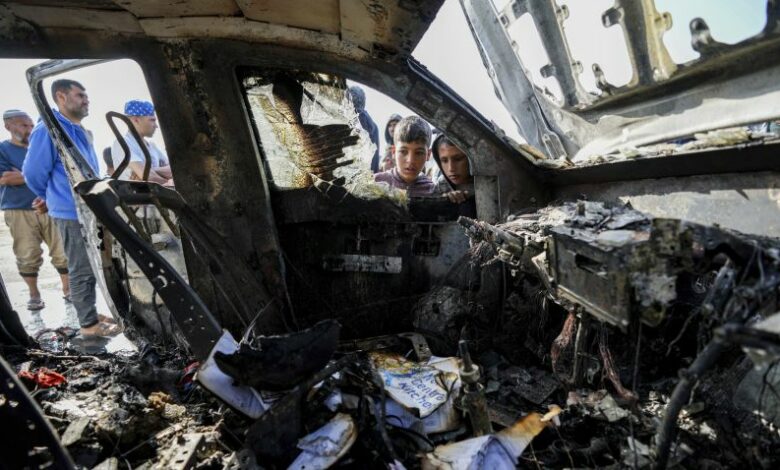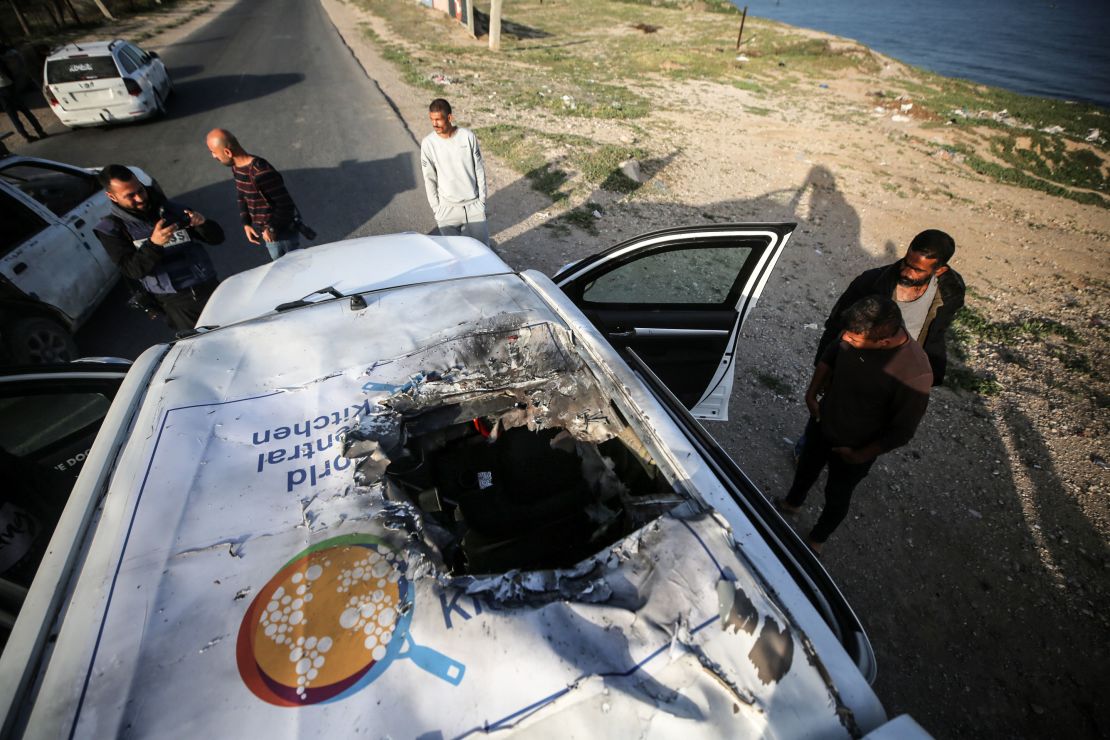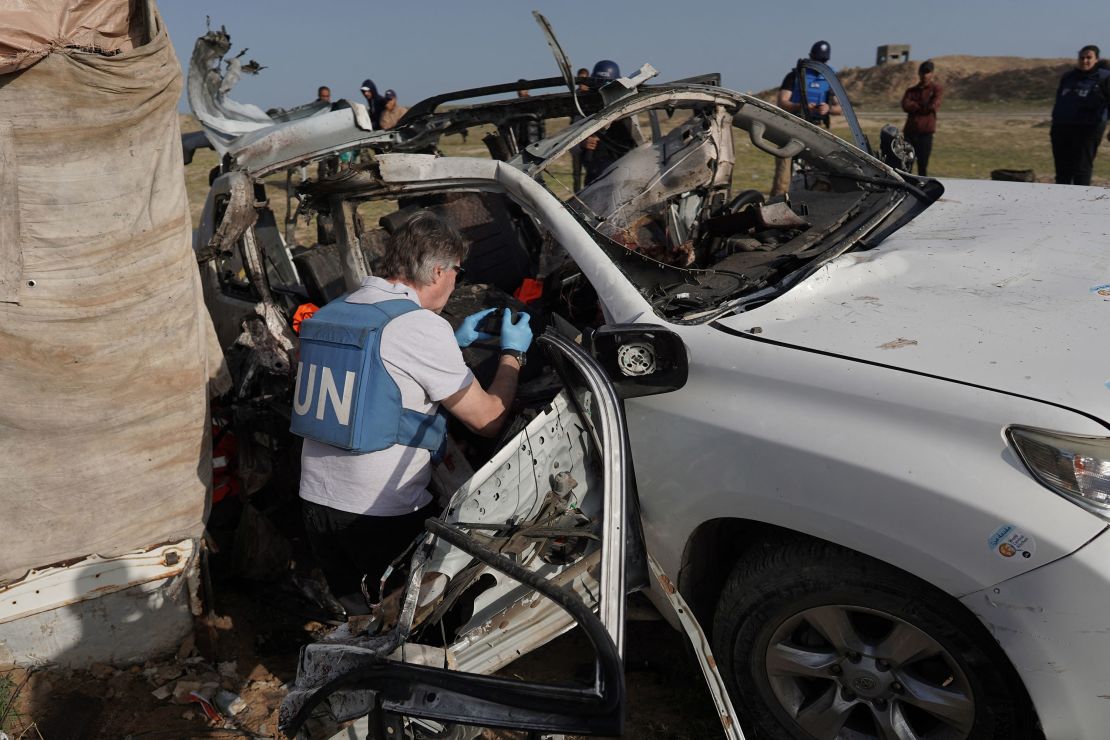
WCK said in a statement Tuesday that its team was traveling in a “deconflicted zone” in two armored cars and one unarmored vehicle, after dropping off more than 100 tons of food supplies at a warehouse in Deir al-Balah in central Gaza, when the attack occurred. The charity said it had coordinated the convoy’s movements with the Israeli military.
CNN geolocated video and imagery of all three destroyed vehicles, at least one of which was clearly marked with a WCK logo on its roof, to two positions on the strip’s Al Rashid coastal road, and a third location on an off-road area of open ground nearby. The first location is around 2.4 kilometers from the third, indicating that the three vehicles were hit by separate strikes.
The first vehicle, which appeared to have suffered extensive fire damage, was geolocated on Al Rashid street just outside Deir al Balah. The second car, which was fire damaged with a hole through its WCK-marked roof, was located around 800 meters down the same road. Al Rashid street is “designated for the passage of humanitarian aid” by Israeli authorities, according to the United Nations Office for the Coordination of Humanitarian Affairs (OCHA).

CNN geolocated the third car, which seems to be the “soft skin” or unarmored vehicle referenced in WCK’s statement and appeared to be the most heavily damaged, to an open field 1.6 km from the second car. The locations of the three cars are around 12 km from the pier recently built for WCK to deliver its aid deliveries to Gaza via boat.
Six foreign nationals were among the seven WCK team members killed in Monday’s strike, which has sparked a growing chorus of global outrage, including from the United States.
In a rare admission of fault, Prime Minister Benjamin Netanyahu said Israel took responsibility for the attack, saying Israeli forces had “unintentionally struck innocent people in the Gaza Strip.”

The chief of staff of the Israeli military, Lt. Gen. Herzi Halevi, apologized for the strike and described it as “a mistake that followed a misidentification.”
“I want to be very clear – the strike was not carried out with the intention of harming WCK aid workers. It was a mistake that followed a misidentification – at night during a war in very complex conditions. It shouldn’t have happened,” Halevi said.
Explosive weapons expert Chris Cobb-Smith told CNN on Tuesday that the strikes appeared to have been carried out by an Israeli drone.
Cobb-Smith, a former British Army artillery officer and munitions expert, said the heavy damage to the three vehicles was consistent with the use of “highly accurate drone fired missiles,” adding it was “hard to believe” the tragic incident was an accident.

The drone that fired the fatal missiles would have been operated in conjunction with a surveillance drone, Cobb-Smith said, meaning the Israeli military would have had total visibility of the cars, including the WCK logo. The “limited blast” and “considerable localized destruction” seen in photos and videos of the aftermath are also consistent with an Israeli UAV strike, he added.
Cobb-Smith told CNN missile fragments would be needed to definitively identify the exact munition used in the strike.
Patrick Senft, a research coordinator at Armament Research Services (ARES), told CNN: “without munition fragments, I can’t say anything for certain, but the damage to the vehicles appears consistent with precision guided munitions with a small explosive payload.” Senft added that the aftermath of the strike “seems consistent with munitions deployed by UAVs.”
CNN has reached out to the IDF for comment on whether the strike was conducted by an Israeli UAV.
Israeli newspaper Haaretz reported on Tuesday that “an Israeli drone fired three missiles one after the other” at the WCK aid convoy as it drove away from the non-profit’s distribution center, citing “defense sources familiar with the details” of the incident.
Defense sources told Haaretz the missiles were launched from a Hermes 450 drone “because of suspicion that a terrorist was traveling with the convoy,” on a food truck. The report adds that though neither the armed man nor the truck he was traveling on left the warehouse, “the war room of the unit responsible for security of the route ordered the drone operators to attack one of the cars with a missile,” according to Haaretz’s defense sources.
CNN is seeking to confirm the details of Haaretz’s reporting.




